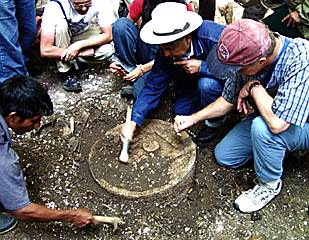
By Marc Zender
Updated April 30, 2004
| April 23, 2004. Guatemala's Minister of Culture today announced a series of exciting new discoveries at the Lowland Guatemalan site of Cancuen (map). Archaeologists from Vanderbilt University, the Universidád del Valle and the Guatemalan Ministry of Culture, led by Dr. Arthur Demarest, have recently uncovered a third ballcourt marker (photo above), an elaborately carved panel, and a large number of well preserved stucco figures decorating the façade of its increasingly impressive Late Classic palace (photo below). |
| Discovery of the third and final ballcourt marker has long been anticipated, not least because three seems to have been the preferred number of such sculptures at other Maya sites, most notably at Lubaantun (in modern-day Belize) and Copan (Honduras). In fact, the new monument is remarkably similar in scale and execution to sculptures discovered at those sites. Sylvanus Morley discovered the first Cancuen ballcourt marker almost ninety years ago, in 1915 (1937-1938, Vol. 5). By contrast, the second ballcourt marker was looted from the site only a few years ago, in 2001, but was quickly recovered in a collaborative effort involving Demarest and the Guatemalan authorities. Its precise original location remained a mystery until the third ballcourt marker was uncovered by Maria Antonieta Cajas-Castillo earlier this month. All three markers now reside at the National Museum of Archaeology in Guatemala City. |

|
|
Federico Fahsen, epigrapher for the Cancuen Archaeological Project, reports that the new monument depicts the great king Tajal Chan Ahk (A.D. 742-799>) playing ball against visiting rulers. Further details of the monument's text and imagery must await its cleaning and restoration, but scholars hope that it will help to clarify the chronology of the second marker (whose date is unfortunately eroded) and cast further light on the remarkable expansion of the Cancuen polity in the late eighth century A.D. (which seems to have involved the annexation of Machaquila). For further details on the historical implications of the previous two ballcourt markers, see the Mesoweb report New Ballcourt Marker from Cancuen.
Other ballcourt excavations conducted by Paola Torres have unearthed an even more spectacular find in the form of a dimunitive but finely carved and well preserved stone panel — "one of the greatest masterpieces of Maya art ever discovered in Guatemala," according to Fahsen. The new panel portrays Tajal Chan Ahk "presiding over a ceremony in the royal plaza of his second capital seat, the city of Machaquila, forty kilometers to the north." The king — depicted centrally wearing a turtle headdress which provides a partial, iconographic spelling of his name — is joined by two flanking sublords (one of sajal rank). Associated hieroglyphs date the event to the 9.18.5.0.0 period ending (September 795). The king sits upon a personified HA' "water" glyph and within a quatrefoil, a supernatural scene that is referenced at other sites. Here it might be intended to evoke associations with Machaquila, where the main plaza is a depression in the form of a quatrefoil and a number of stelae carry the "watery quatrefoil" in the basal register (see Stuart and Houston 1994:33-35, 91). As on the Cancuen Panel, Tajal Chan Ahk here carries both the Cancuen and Machaquila emblem glyphs. Commissioned late in the eighth century A.D., the new panel would appear to confirm Stanley Guenter's vanguard observation that Tajal Chan Ahk claimed suzerainty over Machaquila late in his reign (Guenter, A Reading of the Cancuén Looted Panel; Kistler, The Search for Five-Flower Mountain), and lends further support to Fahsen's interpretations of the wider sociopolitical significance of the ballgame scenes, in which Tajal Chan Ahk appears with an allied king from El Chorro, and alongside other allies or vassals, including the captor of the contemporary king of Machaquila. In another part of the site, Project Co-Directors Tomás Barrientos (Universidád del Valle, Guatemala) and Michael Callaghan (Vanderbilt University) continue to excavate Cancuen's sprawling palace complex — now estimated to contain some 200 masonry rooms and as many as eleven plazas. To restoration expert Rudy Larios falls the daunting task of restoring and conserving hundreds of larger-than-life stucco figures decorating the façades of the palace structures. Enigmatic, fascinating and miraculously well-preserved, the figures are thought to represent deities, deified kings or perhaps even soldiers. As Arthur Demarest observes of Tajal Chan Ahk, "His palace at Cancuen is one of the largest and most splendid in the Maya world, and he used it and his ball court to awe and entertain visiting kings and nobles." (For a further discussion of Cancuen's Palace, see Cancuen Palace Reported.) Just this season, Demarest's project began excavating tunnels into earlier levels of the palace, buried beneath the elegant façades of the late eighth-century court of Tajal Chan Ahk. Undoubtedly, yet further wonders lie in store. |
home
